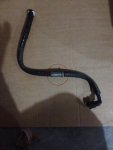swingjunkie
New Member
- Joined
- Oct 28, 2014
- Messages
- 32
- Reaction score
- 0
- Points
- 0
- Vehicle Year
- 1985
- Make / Model
- Ford
- Transmission
- Automatic
1985 Ford Ranger - 2.3 EFI. Debugging low fuel pressure. This component is inline between the high pressure fuel pump out and the fuel rail on the manifold. It is not shown in the manuals that I have. See the attached photo.
I would guess a check valve, but I can't find any info. Anybody have good info? Looks to be OEM equipment and at 29 years of age is suspect. High pressure fuel pump is new. Still reporting 24 PSI on the fuel rail.
Thanks
Carl
I would guess a check valve, but I can't find any info. Anybody have good info? Looks to be OEM equipment and at 29 years of age is suspect. High pressure fuel pump is new. Still reporting 24 PSI on the fuel rail.
Thanks
Carl
Attachments
-
63.2 KB Views: 155















